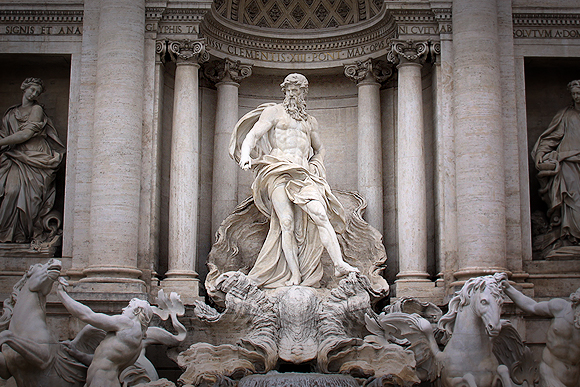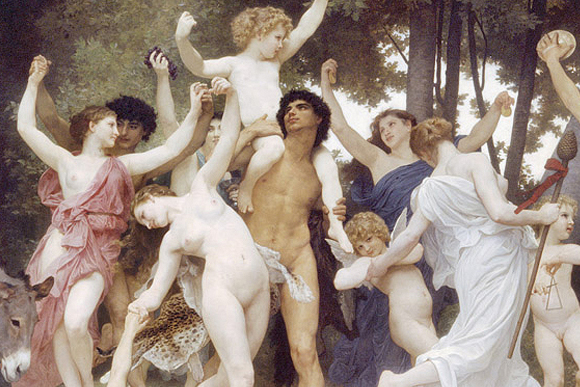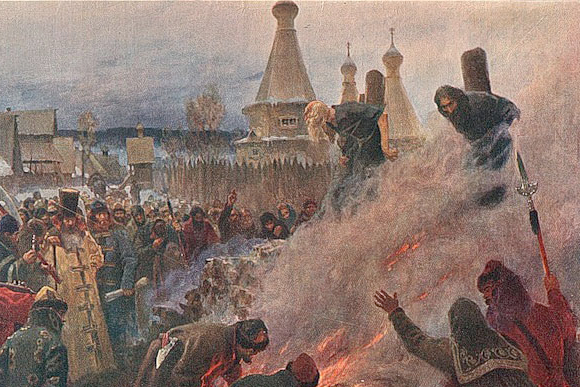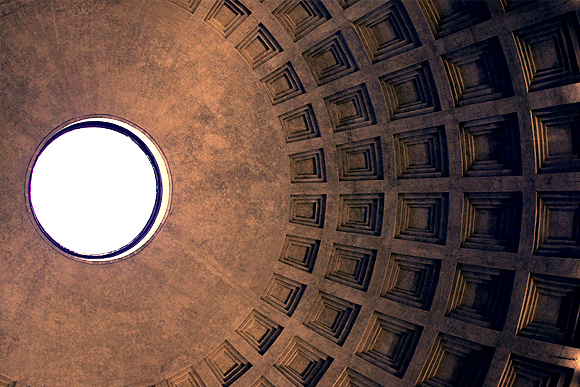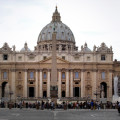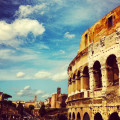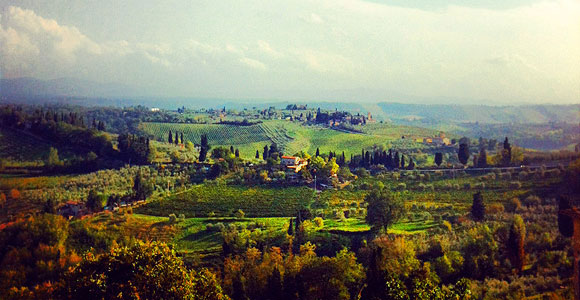Rome has long been the center of the Christian church, but before that, it was a pulsating hub of pagan worship. The few temples and relics that were spared from Christian marauders were must-visits for our trip to Rome: the Temple of Vesta, the Trevi Fountain, and the Pantheon.
Thousands of years ago, the people of Rome worshiped their gods and goddesses in what was called the “mystery religions”; a collection of secret cults which, in my opinion, are the most intriguing of all world religions. Ceremonious rituals that culminated in burning altars and conjured magic; priests and priestesses chanting the names of Venus, Diana, Apollo, and Neptune; full moons and solstice celebrations; a belief system that tied into the fertile earth and her siblings – the seasons, the planets, and the very cycle of life and death. Pagan worship was THE state religion.
But not the only one. Around 68AD, Christianity began to gain significant popularity. In these initial years, people were wary of this new one god, and – as mankind has proven to always do in the face of change – they bulled and mercilessly persecuted it’s disciples. Despite this, by 313 Christianity was recognised as a legal religion. Then, as if in retaliation, the tables turned. It look less than 80 years for Paganism to be outlawed by Emperor Theodosius I. Temples were plundered and destroyed. Pagans were persecuted with heights of inhumanity that their Christian counterparts were previously spared from. Eventually, they were even banned from employment, given no chance of survival except to convert. (This reminds me of the treatment of the Jews during the Holocaust, although they were not afforded the luxury of conversion.) Even the ancient sport of the Olympic Games were banned during this period!
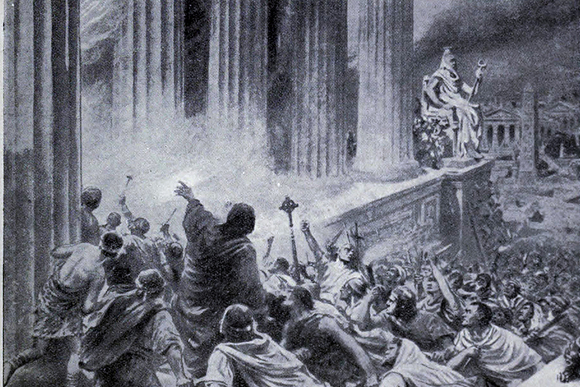
The destruction of the Library in Alexandria in 391 AD, under order from Theodosius I. Credit: Ambrose Dudley
The new festival of Christmas was specifically placed on the same date as the Pagan Saturnalia (also known as Yule, or the Winter Solstice), intended to push the old religion into the shadows. Similarly with Easter, placed on the same date as Eostre, and All Saints Day, which overshadows Samhain (also known as All Hallows Eve, or Halloween) – all designed to create a Christian dictatorship. The priests of the time crafted an incredible storybook and used it to force the Roman Empire into fearful submission, under the apparent will of their benevolent god. A new world order had been born. Unfortunately for the people, it wasn’t born out of this benevolent god, but from his corrupted priests.
But I digress.
Visiting Rome, for me, was a walk through the annals of history. From the ruins of the barbaric Colosseum, to the chariot-worn cobblestones of the Roman Forum, I savoured every moment, every page in the chapter of ancient Rome.
In fact, one of the most well-known relics from old-world Rome is the Temple of Vesta, in the House of the Vestal Virgins at the Roman Forum. The first of three Pagan sites that we visited, it was also the most devastated.
Vesta was the most divine of all gods and goddesses. Her worship was celebrated at the heart of the Roman home – the fireplace that brought warmth and food to the family. Her temple in Rome housed the only priesthood that existed before Christianity – no other deity was as divine as to merit a group of their own, private, holy clergy.
Her priestesses, the Vestal Virgins, swore an oath of chastity for thirty years, and served in the temple with one ultimate goal; don’t let the hearth go cold. For Romans believed that the sacred fire of Vesta was intrinsically tied to the fate of the city; should it go out, Rome would surely meet with disaster.
One of these priestesses was Rhea Silvia – a woman backed by an intriguing history:
Legend has it, Rhea’s mutinous uncle overthrew her father, Numitor the King of Alba Longa; killed her brother, heir to the throne; and sentenced Rhea to celibacy in the Temple of Vesta so as to not produce any further heirs. He claimed the throne as his own.
However, his plan was thwarted when Rhea bore two sons with the god Mars – you’ll have heard of these famous twins before – Romulus and Remus. Learning of the news, he ordered a servant to steal away the infants and dispose of them, but the servant, too soft-hearted, instead set them adrift on the River Tiber. As fortune would have it, they were rescued and raised by a she-wolf, and eventually grew up to found Rome, and re-instate their grandfather as King. Rhea, as she had broken her oath of celibacy, was sentenced to be buried alive, returning to the earth that bore her, but instead was rescued and married by the god of the River Tiber, Tiberinus.
But the Temple of Vesta did not withstand the ravages of time. I mentioned above that it was in the reign of Emperor Theodosius I when the Pagan temples suffered the most; not only did he allow the massacre of his people, but as a final act to extinguish the Pagan presence in Rome, he went so far as to snuff out the ever-burning flame in the hearth of the Temple of Vesta. And, sure enough, within a year, Theodosius was dead, and the mighty Empire of Rome was already in steady decline, divided by his sons, and never to be united again.
1200 years later, like all other Pagan relics in the wake of Christianity, the temple was pillaged for it’s marble, used instead to build Christian churches and papal palaces.
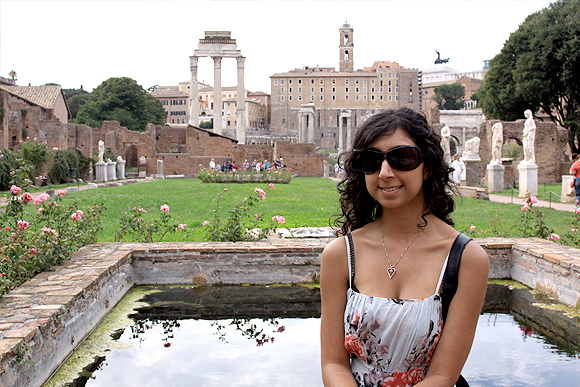
All that remains of the House of the Vestal Virgins is a bath, a few broken statues, and crumbling walls.
Despite the destruction of her temple, the legacy of Vesta lives on, still, in the Trevi Fountain.
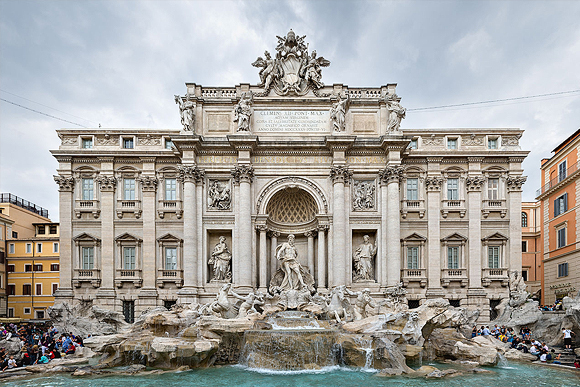
Credit: David Iliff. License: CC-BY-SA 3.0
It is said that Vesta and Caelus (also known as Sky) were parent to Ocean, the central figure of the magnificent fountain. But not only Ocean features in what is known to be the largest Baroque fountain in Rome. He is accompanied by two Tritons beside his horses; by Abundance and Health on his left and right; 30 species of plants and a multitude of small animals; and by two scenes depicting the legend of the fountain’s discovery.
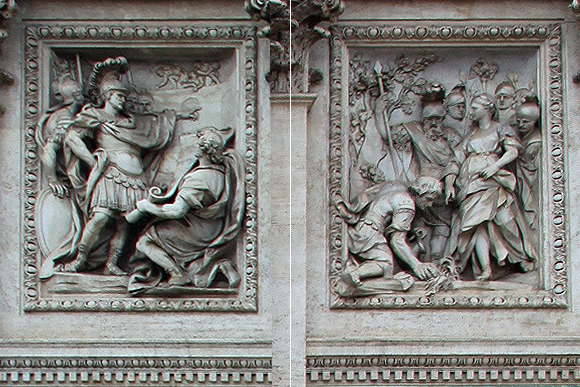
The top right corner of the fountain shows a young girl guiding thirsty Roman officers to fresh water in 19BC. The top left corner of the fountain shows Emperor Augustus commanding the construction of a 22km aqueduct to Rome, named for the young girl, “Aqua Virgo”, or “Virgin Waters”. The aqueduct, built by Augustus’ son-in-law and army General, Marcus Agrippas, served Rome until the fall of the Empire.
What does all this have to do with the Pagan’s, you ask? Apart from the deities featured in the fountain, the famous ritual of throwing a coin into the waters has roots in Pagan lore.
Some say that this tradition began in ancient Rome, when the people would pray to the Roman water gods and goddesses. Turning their back and closing their eyes in fear of being turned into a statue themselves, they would throw an offering into the water, and pray for good fortune. No doubt there were other ceremonious elements involved, but it is comforting to see that some of the original ritual has remained.
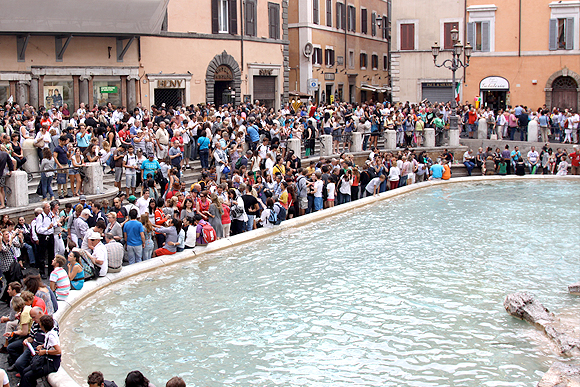
The Trevi Fountain has now been taken over by the Church. Roughly 3,000 Euros are swept up from the bottom of the fountain each day, and donated to a Christian charity.
Also commissioned by Marcus Agrippa during the reign of Augustus, the Pantheon is my favourite of all old-world relics. The original temple was constructed in 27BC, but later destroyed along with most of Rome in the great fire of 80AD. It was rebuilt by the Emperor Hadrian thirty years later, who has gone down in the history to be known as one of the Five Good Emperors of Rome. Machiavelli describes him:
From the study of this history we may also learn how a good government is to be established; for while all the emperors who succeeded to the throne by birth, except Titus, were bad, all were good who succeeded by adoption, as in the case of the five from Nerva to Marcus. But as soon as the empire fell once more to the heirs by birth, its ruin recommenced…
Titus, Nerva, Trajan, Hadrian, Antoninus, and Marcus had no need of praetorian cohorts, or of countless legions to guard them, but were defended by their own good lives, the good-will of their subjects, and the attachment of the senate.
Not only did he restore the Pantheon to it’s former glory, but he built the largest temple in all of ancient Rome, the Temple of Venus and Roma, dedicated to “Venus the Bringer of Good Fortune” and “Eternal Rome”. He also passed laws for more humane treatment of slaves (for example, masters were no longer allowed to kill their slaves, sell them into prostitution or to slave-labour camps, nor were they allowed to send them to the Colosseum for gladiator battle), and established the cult of Hellenism (the love of Greek culture), including becoming an icon for the new fashion of wearing a beard!

It’s true, Hadrian was the pin-up boy for ancient hipsters. All Emperors before him were clean-shaven. Those that followed all wore beards.
Credit: The Wall Street Journal
But I digress again.
The very name “Pantheon” itself translates to “a temple for all gods” in Greek – so it’s no wonder that many people believe this iconic structure was originally intended to be a Pagan house of worship. The architecture of the building itself proves the theory. Inside, seven altar-like niches are carved into the circumference of the wall, perfectly suited to house statues of the seven deities represented by the only planets known to the ancient Romans; Apollo (the Sun), Diana (the Moon), Mars, Mercury, Jupiter, Venus, and Saturn. The circular design of the temple meant that each deity would have had equal weighting – again, in accordance with the Pagan belief that there was not one great god, but many gods and goddesses whom were all as holy as each other.
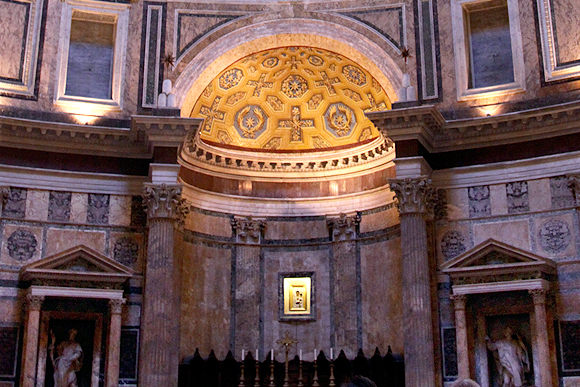
Today, Christian statues lie in place of the Pagan ones. You can see them on either side of this photo.
Personally, I think the magnificent dome gives it all away. The perfect vessel for worship of the moon, I just imagine the rituals that were held in the Pantheon in ancient times. Sandalwood incense would have burned, thickening the air with fragrant smoke. Hooded priestesses would have chanted under the full, pregnant orb, perfectly framed in the halo of stone above them. The patterned dome, radiating outwards like the rays of the moon would have captured the light of a blazing fire… What better purpose could the dome serve than this?
But by medieval Rome, the pantheon was converted into a Christian church. In 609, Pope Boniface IV asked of the Emperor Phocas:
…in the old temple called the Pantheon, after the pagan filth was removed, a church should be made, to the holy virgin Mary and all the martyrs, so that the commemoration of the saints would take place henceforth where not gods but demons were formerly worshipped.
In retrospect, it was a blessing that Pope demanded the Pantheon for the Church. Over the course of the following centuries, much of Rome’s ancient buildings were pillaged for bronze and marble. The Pantheon, too, was robbed of some of it’s finery, but for the most part was left in-tact. According to historian and monk, Paul the Deacon:
Remaining at Rome twelve days [Emperor Constans II] pulled down everything that in ancient times had been made of metal for the ornament of the city, to such an extent that he even stripped off the roof of the church, which at one time was called the Pantheon, and had been founded in honour of all the gods and was now by the consent of the former rulers the place of all the martyrs; and he took away from there the bronze tiles and sent them with all the other ornaments to Constantinople.
Since then, the Pantheon is still used for Christian masses, as well as a tomb for a selection of historical figures.

Among others, it is the final resting place for Raphael, renowned Renaissance painter.
If you ask me, you couldn’t ask for a more glorious palace to rest your old bones.
Have you visited any relics of Pagan Rome? What was your favourite?
 Enjoyed this post? Read the next post from this series: “A Honeymooner’s Guide to six weeks in Europe” now!
Enjoyed this post? Read the next post from this series: “A Honeymooner’s Guide to six weeks in Europe” now!


